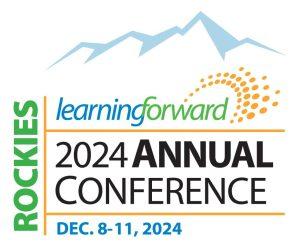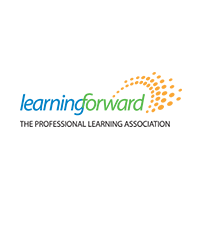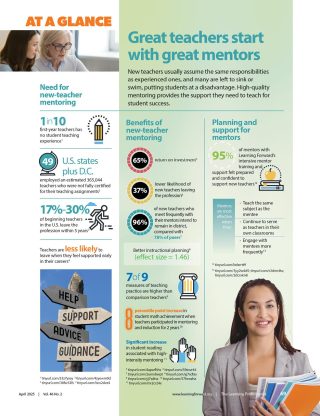Artificial Intelligence (AI) is on educators’ minds and on the agenda for the Learning Forward 2024 Annual Conference in Aurora, Colorado. Educator and innovator A.J. Juliani will give a keynote address about meaningful and relevant practices for teaching and learning in the age of AI and distraction. He’ll share insights, strategies, and examples to help educators prepare themselves and their colleagues for the future of teaching and learning. 
Juliani is the author of Adaptable and several other books on education innovation, founder of Adaptable Learning, and an instructor at the University of Pennsylvania Graduate School of Education Penn Literacy Network. He was formerly director of learning and innovation for Centennial School District in Pennsylvania and has worked as a curr iculum coordinator, tech director, English teacher, football coach, and K-12 instructional coach.
iculum coordinator, tech director, English teacher, football coach, and K-12 instructional coach.
The title of your conference keynote is “Learning in the AI age.” What has changed about teaching and learning since AI tools became widely available in the past couple of years?
Right now, we are at a hinge of history. There have been a lot of technological advancements that changed human history, like the printing press, the telegraph, the personal computer, and we didn’t know how big the impacts were going to be. But with AI, pretty much everybody agrees, we’re in a moment when everything is going to change, including in schools. How do we handle that, as educators, as leaders, as folks who are leading professional learning?
We’re also living with a challenge from the last real hinge of history — the internet. We’re now living in an era where people are very distracted because we’re walking around with devices buzzing, computers in our pockets, and 18 tabs open on the web browser. There’s a term that (technology writer and consultant) Linda Stone came up with to describe this: continuous partial attention. And here comes AI, which could be the biggest distraction ever.
In an era of AI and distraction, a lot of things that previously worked with our students aren’t working. So how does learning need to change? We have to make learning meaningful and relevant for our learners, more so than ever before — and that’s all learners, including our adult professional learners.
AI can actually help us create these more engaging and meaningful and relevant lessons, activities, assignments. But the flip side is that we also have to be more human than ever in an AI world. No one wants teachers to use AI to create all the lesson plans and kids using AI to do all the work. We need to keep the human, the social, the meaning center, the language base. It’s a fine balance, and something I’ll be sharing in some stories and examples at the conference.
Navigating AI in the classroom can feel overwhelming. What’s your advice about how to start?
We should address the use of AI on every assignment. There are certain ways that we can do that, to make it a little bit easier for educators, students, and parents.
One example is a traffic light protocol that Garnet Valley School District in Pennsylvania is using. In this protocol, red is no use of AI allowed, yellow is kids can ask for permission, and green is an open case scenario. When teachers see this protocol, their first reaction is often that an assignment has to be just one of those colors. But educators who are becoming proficient with using AI are weaving all three of those into an assignment or project.
So the teacher might start the class with a writing assignment, and say, “For the first 30 minutes of class, we are going to be completely red. I want you brainstorming topics and finding some things from the text that you want to write about.” And then after that first 30 minutes, the teacher says, “For the rest of the class, we’re going to be yellow. Take your top two topics and flesh out an outline of what your essay might be. You can use Google or Microsoft AI tools if you want to, but you don’t have to.”
The kids finish class with their outlines, and when they come back the next day, the teacher says, “We’re going to red again to flesh out your outline into a rough draft. This is all you. Write stream of consciousness, not editing, for the next 30 minutes.” Then when they’ve got a rough draft, the teacher says, “For homework, we’re going to go green. You can take that rough draft and use Grammarly, spell check, whatever, to flesh it out into a final draft.”
By using the Draftback extension in Google docs, the teacher can then look back at the entire writing process, play a video of it, and understand how the students got from the first draft to the final. That’s what it looks like to use technology purposefully in the classroom.
How have you seen student learning change when you use that protocol?
A key piece is for the teacher to say, “Be prepared when you come into class tomorrow to talk about how AI helped you — what the changes were from the rough draft, what the benefits were, and some of the drawbacks.” And when they come back for that discussion, I promise, you’ve never seen such engaged peer conversation before.
And, when we open up the opportunities and conversations, kids start coming and saying, “Can I use Grammarly to proofread this?” or “Can I use Photomath if I get stuck on a problem?” If we don’t allow the conversation to happen, both of those scenarios would just be cheating. Instead, they’re supporting learning.
What you’re describing sounds amazing, but it also sounds like a lot of work, at least in the beginning.
I think it’s like anything else — when you first do it, it can feel overwhelming. So I tell people to start small. Just start with the brainstorming and outlining piece. And then the next time you assign a paper, add the rough draft piece, and so on. Eventually, you get to the full process.
One of the stepping stones I have teachers do to start using AI is give students an assignment and then say, “Here’s what AI created when I gave it this assignment.” It might be a lab report, or a paragraph response, or an essay. Then they ask students to improve upon what the AI did, to make it a B-level or A-level response. This acknowledges that what AI puts out isn’t as good as what students can do when they bring their thinking to it.
Where it gets easier for teachers is when they start to understand the flow of when they want to use AI versus when they don’t. Walking teachers through some of these processes helps them because it eliminates the confusion a little bit. And what I’ve seen with teachers everywhere is that it’s like any other kind of pedagogical change — it’s going to take time, it’s going to be new, but then they start seeing the benefit with the students.
What does it look like to facilitate professional learning for this kind of teaching? How do you do that at scale?
I’ll start with what not to do. One of the biggest issues I see is tool-based professional learning, where educators are just learning about one specific technology tool. We need embedded professional learning opportunities and activities that are framed around the pedagogical issue at hand and then talk about how AI can help us in this context. It can’t just be, “Hey, there’s this new cool tool that will help you save time.” Technology has to be embedded into the context of your PLC, your department team, your grade-level planning, or whatever your collaborative learning looks like.
Instead of starting with, “Today we’re going to learn how to use Curipod,” I start with the learning goal. I’ll say, “Who wants to have more interactive classroom discussions — the kind where, every time you ask a question, 25 hands go up instead of the same three that usually do?” All the educators tune in. And then I say, “Tell me something you really struggled to get the kids talking about.” Once we all know what we’re trying to accomplish and why, I walk them through the process of using Curipod to get the whole class engaged.
Also, when I share a new tool, I don’t do it under the premise that it saves time. For example, when I use Magic School, I start by showing them the first two tools on the site — worksheet generator and quiz generator — and I say, “We’re going to scroll past those because what we’re trying to do is create more meaningful and relevant lessons, not make it faster to do the same old thing.”
I go to my favorite section, which is called “make it relevant” and I ask the teachers what their kids are into, and I show them how the tool generates different ideas for making a real-world connection between the lesson and students’ interests, whether it’s sports or Taylor Swift or whatever. Then, we take one of those ideas and flesh it out with a lesson planning protocol. I point out that we still need our human intelligence to take what the artificial intelligence did, how it got us started down the path, and flesh it out into something that you can actually use.
I’m not trying to put you out of business, but it sounds like we don’t need a tech expert to run the professional learning. We need the people who are facilitating PLCs, coaching, and the like to open these discussions.
Right. I think the term “tech expert” is something that doesn’t even really exist in today’s world. I remember when my school district went one-to-one (one computer per student), and I was a K-12 technology staff developer. For my first six months, I was just kind of showing them how to use stuff. But I realized when I started doing some classroom walk-throughs that a lot of classrooms were just using technology in a passive way — as what we called a teenage pacifier. I felt like there was something really wrong with that, so I started focusing on embedding the technology into learning goals. Eventually, it started to be something that teachers really wanted.
As simple as it sounds, our role as facilitators of any type of professional learning is to figure out: How can this lead to better learning experiences? Technology can be a piece of that, but without the pedagogy and the instructional practices behind it, the technology falls flat
What do you want school and district leaders to know about AI professional learning?
We need professional learning now more than ever. It’s a little bit worrisome for me that we’ve been so slow to develop professional learning around this. With previous technologies like one-to-one initiatives, we had three-year rollout plans, embedded technology coaches, and more. But we don’t have that kind of time with AI. It’s here — it’s on every single one of our devices and our kids’ devices. So the conversations about how to use it have to be embedded in our professional learning. We have to get beyond simple questions like “How can we use it to save time?” We have to say, “How can we use this for good, from a pedagogical and instructional perspective?”
Learn more from A.J. Juliani at the Learning Forward Annual Conference on December 11, 2024.
Download the PDF here.

Learning Forward is the only professional association devoted exclusively to those who work in educator professional development. We help our members plan, implement, and measure high-quality professional learning so they can achieve success with their systems, schools, and students.
Recent Issues
BUILDING BRIDGES
December 2024
Students benefit when educators bridge the continuum of professional...
CURRICULUM-BASED PROFESSIONAL LEARNING
October 2024
High-quality curriculum requires skilled educators to put it into...
LEARNING TO PIVOT
August 2024
Sometimes new information and situations call for major change. This issue...
GLOBAL PERSPECTIVES
June 2024
What does professional learning look like around the world? This issue...












